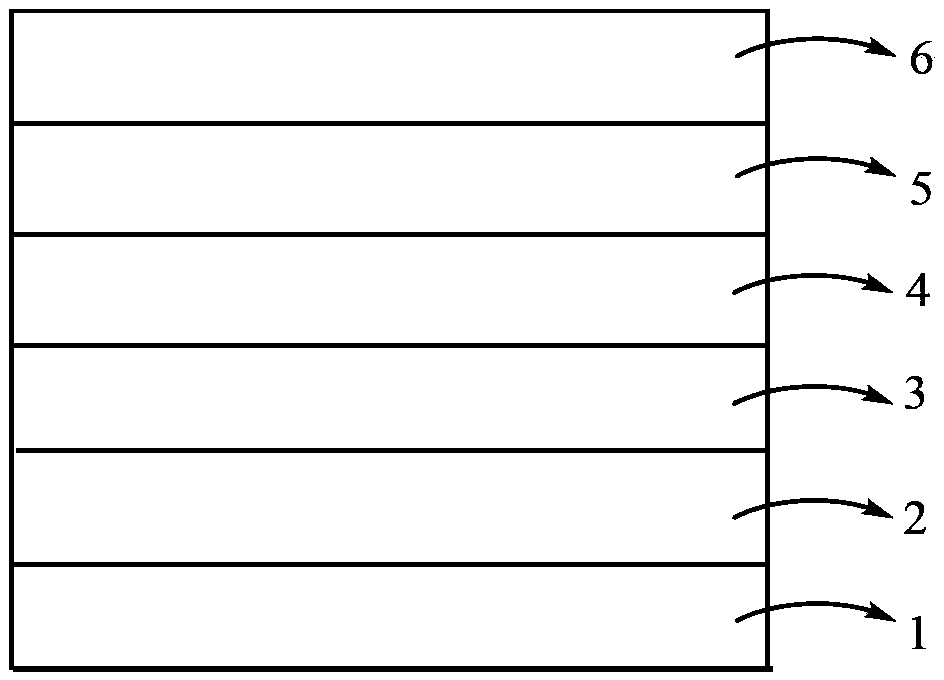Copolymer blue light host material, preparation method thereof and organic electroluminescent device
A technology of blue light host material and copolymer, applied in luminescent materials, electro-solid devices, semiconductor devices, etc., can solve the problems of poor thermal stability and low luminous efficiency, and achieve excellent film-forming performance, high electroluminescence efficiency, high efficiency improved effect
- Summary
- Abstract
- Description
- Claims
- Application Information
AI Technical Summary
Problems solved by technology
Method used
Image
Examples
Embodiment 1
[0032] The copolymer blue light host material of this embodiment, that is, poly{2,7-diyl-9,9-bis(4-n-hexyloxybenzene)fluorene-co-(4,4'-(2,7-di Base-9H-fluorene-9,9-diyl)bis(4,1-phenylene))bis(diphenylphosphine oxide)} (represented by P1) (where R is n-hexyl, n=57), Its structural formula is as follows:
[0033]
[0034] The preparation steps of above-mentioned polymer are as follows
[0035] The reaction formula is as follows:
[0036]
[0037] Under argon protection, 9,9-bis(4-n-hexaneoxybenzene)fluorene-2,7-dipinacol borate (154mg, 0.2mmol), (4,4'-(2, 7-Dibromo-9H-fluorene-9,9-diyl)bis(4,1-phenylene))bis(diphenylphosphine oxide) (175mg, 0.2mmol) was added to a flask containing 10ml of toluene solvent, fully After dissolving, potassium carbonate (2mL, 2mol / L) solution was added to the flask, vacuumed to deoxygenate and filled with argon, then bistriphenylphosphine palladium dichloride (5.6mg, 0.008mmol) was added; the flask was heated The Suzuki coupling reaction wa...
Embodiment 2
[0040] The copolymer blue light host material of this embodiment, that is, poly{2,7-diyl-9,9-bis(4-methoxybenzene)fluorene-co-(4,4'-(2,7-diyl -9H-fluorene-9,9-diyl)bis(4,1-phenylene))bis(diphenylphosphineoxy)} (represented by P2) (where R is methyl, n=82), its structural formula as follows:
[0041]
[0042] The preparation steps of above-mentioned polymer are as follows:
[0043] The reaction formula is as follows:
[0044]
[0045] Under the protection of a mixed gas of nitrogen and argon, 9,9-bis(4-methoxybenzene)fluorene-2,7-dipinacol borate (189mg, 0.3mmol), (4,4'- Add (2,7-dibromo-9H-fluorene-9,9-diyl)bis(4,1-phenylene))bis(diphenylphosphine oxide) (263mg, 0.3mmol) and 15mL tetrahydrofuran into two ports of 50mL In the bottle, after fully dissolving, introduce a mixture of nitrogen and argon to exhaust the air for about 20 minutes, then add tetrakistriphenylphosphine palladium (4mg, 0.003mmol) into it, and then add sodium bicarbonate (3mL, 2mol / L) solution. T...
Embodiment 3
[0048] The copolymer blue light host material of this embodiment, that is, poly{2,7-diyl-9,9-bis(4-n-eicosyloxybenzene)fluorene-co-(4,4'-(2,7 -diyl-9H-fluorene-9,9-diyl) two (4,1-phenylene)) two (diphenylphosphine oxygen)} (represented by P3) (wherein, R is n-eicosyl group, n =40), its structural formula is as follows:
[0049]
[0050] The preparation steps of above-mentioned polymer are as follows:
[0051] The reaction formula is as follows:
[0052]
[0053] Under nitrogen protection, 9,9-bis(4-n-eicosyloxybenzene)fluorene-2,7-dipinacol borate (349mg, 0.3mmol), (4,4'-(2, 7-Dibromo-9H-fluorene-9,9-diyl)bis(4,1-phenylene))bis(diphenylphosphine oxide) (289mg, 0.33mmol), palladium acetate (3.5mg, 0.015mmol) and Tris(o-methoxyphenyl)phosphine (21mg, 0.06mmol) was added into a flask filled with 12mL of N,N-dimethylformamide, and after fully dissolving, potassium carbonate (3mL, 2mol / L) solution was added, Then nitrogen was passed into the flask to exhaust the air for a...
PUM
| Property | Measurement | Unit |
|---|---|---|
| Thickness | aaaaa | aaaaa |
| Thickness | aaaaa | aaaaa |
| Thickness | aaaaa | aaaaa |
Abstract
Description
Claims
Application Information
 Login to View More
Login to View More - R&D Engineer
- R&D Manager
- IP Professional
- Industry Leading Data Capabilities
- Powerful AI technology
- Patent DNA Extraction
Browse by: Latest US Patents, China's latest patents, Technical Efficacy Thesaurus, Application Domain, Technology Topic, Popular Technical Reports.
© 2024 PatSnap. All rights reserved.Legal|Privacy policy|Modern Slavery Act Transparency Statement|Sitemap|About US| Contact US: help@patsnap.com










